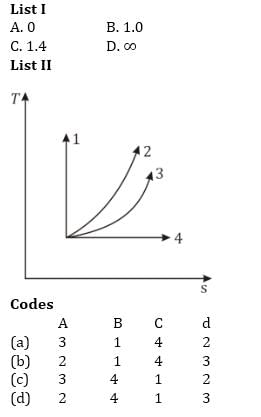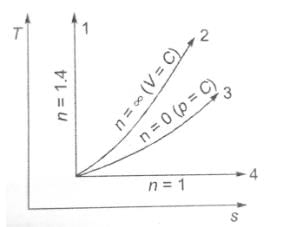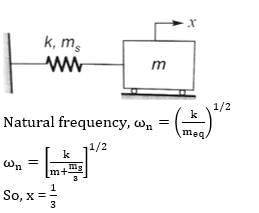All questions of CBT II for Mechanical Engineering Exam
In centrifugal pump, cavitation is reduced by:- a)Increasing the flow velocity
- b)Reducing discharge
- c)Throttling the discharge
- d)Reducing suction head
Correct answer is option 'D'. Can you explain this answer?
In centrifugal pump, cavitation is reduced by:
a)
Increasing the flow velocity
b)
Reducing discharge
c)
Throttling the discharge
d)
Reducing suction head

|
Tarun Kaushik answered |
Cavitation is the phenomenon of the formation of vapour bubbles of a flowing liquid in a region where the pressure of the liquid falls below the vapour pressure of the fluid and sudden collapsing of these bubbles in the region of higher pressure.
In centrifugal pumps the cavitation may occur at the inlet of the impeller of the pump or at the suction side of the pumps, where the pressure is considerably reduced.
Hence if the pressure at the suction side of the pump drops below the vapour pressure of the liquid then cavitation may occur.
In order to determine whether cavitation will occur in any portion of the suction side of the pump, the critical value of Thoma’s cavitation factor (σ) is calculated.

H = Head developed by the pump
HS = Suction pressure head in m of water
HV = Vapour pressure head in m of water
hLS = Head lost due to friction in the suction pipe
If the value of σ is greater than σc (Critical cavitation factor), the cavitation will not occur in that pump.
So, the cavitation can be reduced by reducing the suction head.
A slider moves with uniform velocity ‘v’ on a revolving link of length ‘l’ with angular velocity ‘ω’. The Coriolis acceleration component of point on the slider relative to a coincident point on the link is equal to- a)ωv parallel to the link
- b)2ωv perpendicular to the link
- c)ωv perpendicular to the link
- d)2ωv parallel to the link
Correct answer is option 'B'. Can you explain this answer?
A slider moves with uniform velocity ‘v’ on a revolving link of length ‘l’ with angular velocity ‘ω’. The Coriolis acceleration component of point on the slider relative to a coincident point on the link is equal to
a)
ωv parallel to the link
b)
2ωv perpendicular to the link
c)
ωv perpendicular to the link
d)
2ωv parallel to the link
|
|
Mita Mehta answered |

A tank containing air is stirred by a paddle wheel. The work input to the paddle wheel is 9000 kJ and the heat transferred to the surrounding from the tank is 3000 kJ. The external work done by the system is- a)zero
- b)3000 kJ
- c)6000 kJ
- d)9000 kJ
Correct answer is option 'A'. Can you explain this answer?
A tank containing air is stirred by a paddle wheel. The work input to the paddle wheel is 9000 kJ and the heat transferred to the surrounding from the tank is 3000 kJ. The external work done by the system is
a)
zero
b)
3000 kJ
c)
6000 kJ
d)
9000 kJ
|
|
Shubham Sharma answered |
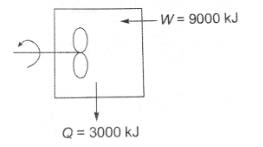
This is a case of a constant volume process or an isochoric process. In an irreversible constant volume process, the system doesn’t perform work on the surrounding at the expense of its normal energy. By performing work on the system, the temperature can be raised.
Hydraulic grade line as compared to the centre line of conduct ______.- a)Should always be above
- b)Should be always below
- c)Should always be parallel
- d)May be above or below
Correct answer is option 'A'. Can you explain this answer?
Hydraulic grade line as compared to the centre line of conduct ______.
a)
Should always be above
b)
Should be always below
c)
Should always be parallel
d)
May be above or below
|
|
Tejas Verma answered |
Bernoulli's equation along streamlines

Total head (H) = Pressure head (P/ρg) + Kinetic head (v2/2g) + Potential head (z)
Total head (H) = Hydraulic gradient line ((P/ρg) + z) + Kinetic head (v2/2g)
The line representing the sum of pressure head, datum head, and velocity head with respect to some reference line is known as total energy line (T.G.L).
The line representing the sum of pressure head and potential head or datum head with respect to some reference line is the hydraulic gradient line (H.G.L) which is always above compared to the centre line of conduct.
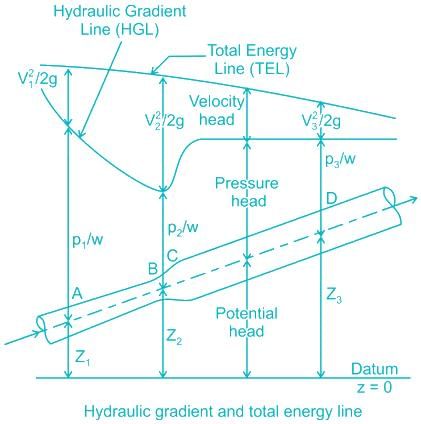
From a uniform disc of radius R an equilateral triangle of side √3R is cut as shown in figure. The new position of centre of mass is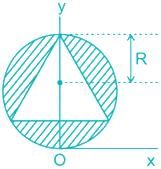
- a)(0, 0)
- b)(0, R)
- c)(R, 0)
- d)(0, √3/2R)
Correct answer is option 'B'. Can you explain this answer?
From a uniform disc of radius R an equilateral triangle of side √3R is cut as shown in figure. The new position of centre of mass is

a)
(0, 0)
b)
(0, R)
c)
(R, 0)
d)
(0, √3/2R)

|
Crack Gate answered |
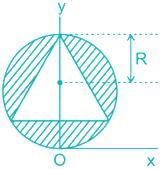
It is an equilateral triangle of side √3R (say a).
Height of the triangle:
H = √(a2 – a2/4) = √3a/2

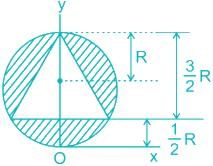
Position of centre of mass: COM = (0, R)
COM = (0, R)
 COM = (0, R)
COM = (0, R)Hints:
The vertices of the triangle are on the circumference. The circle is the circumcircle. It is symmetric about the centre of the circle. The centroid of the triangle coincides with the centre of the circle. So, after the triangle is cut out, the remaining mass is symmetric about the centre. Hence the centre of mass remains at the same position.
Moment of inertia about an axis perpendicular to the plane of an area is known as- a)First moment
- b)the Second moment
- c)Polar moment
- d)Axial moment
Correct answer is option 'C'. Can you explain this answer?
Moment of inertia about an axis perpendicular to the plane of an area is known as
a)
First moment
b)
the Second moment
c)
Polar moment
d)
Axial moment
|
|
Tejas Verma answered |
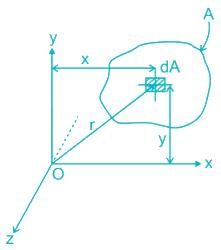
Polar moment of inertia:
The moment of inertia about an axis perpendicular to the plane of an area is known as the polar moment of inertia.
Let Oz be the axis perpendicular to the axis Ox and Oy passing through the origin O.
Moment of inertia of area of plane lamina about Oz axis is given by:

The moment of inertia of an area about an axis perpendicular to its plane (polar moment of inertia) at any point O is equal to the sum of moments of inertia about any two mutually perpendicular axis passing through the same point O and lying in the plane of area.
The ratio of Young’s moduli of elasticity of two materials is 2.35. Find the ratio of the stresses in two bars of these materials if they are of the same length and same area and subjected to the same force P.- a)1: 1
- b)1: 2
- c)1: 2.35
- d)2.35: 1
Correct answer is option 'A'. Can you explain this answer?
The ratio of Young’s moduli of elasticity of two materials is 2.35. Find the ratio of the stresses in two bars of these materials if they are of the same length and same area and subjected to the same force P.
a)
1: 1
b)
1: 2
c)
1: 2.35
d)
2.35: 1
|
|
Tejas Verma answered |
E1: E2 = 2.35: 1
L1 = L2 = L; A1 = A2 = A; P1 = P2 = P
Stress is defined as the force intensity or force per unit area.

Note:
Now ratio of strain would be,
The ratio of change in dimension of the body to the original dimension is known as strain.
ϵ = σ/E
σ = P/A

Calculate the hydrostatic pressure for water moving with constant velocity at a depth of 5 m from the surface.- a)49 kN/m2
- b)98 kN/m2
- c)since fluid is in motion, we cannot analyse
- d)None of the mentioned
Correct answer is option 'A'. Can you explain this answer?
Calculate the hydrostatic pressure for water moving with constant velocity at a depth of 5 m from the surface.
a)
49 kN/m2
b)
98 kN/m2
c)
since fluid is in motion, we cannot analyse
d)
None of the mentioned
|
|
Mita Mehta answered |
If fluid is moving with uniform velocity we treat it analytically same as if fluid is at rest
p= ρgh.
If a body is acted upon by a number of coplanar non-concurrent forces, it may- a)rotate about itself without moving
- b)move in any one direction rotating about itself
- c)be completely at rest
- d)all of these
Correct answer is option 'D'. Can you explain this answer?
If a body is acted upon by a number of coplanar non-concurrent forces, it may
a)
rotate about itself without moving
b)
move in any one direction rotating about itself
c)
be completely at rest
d)
all of these
|
|
Shubham Sharma answered |
If all the forces in a system lie in a single plane and the lines of action of all the forces do not pass through a single point, the system is said to be a coplanar non-concurrent force system.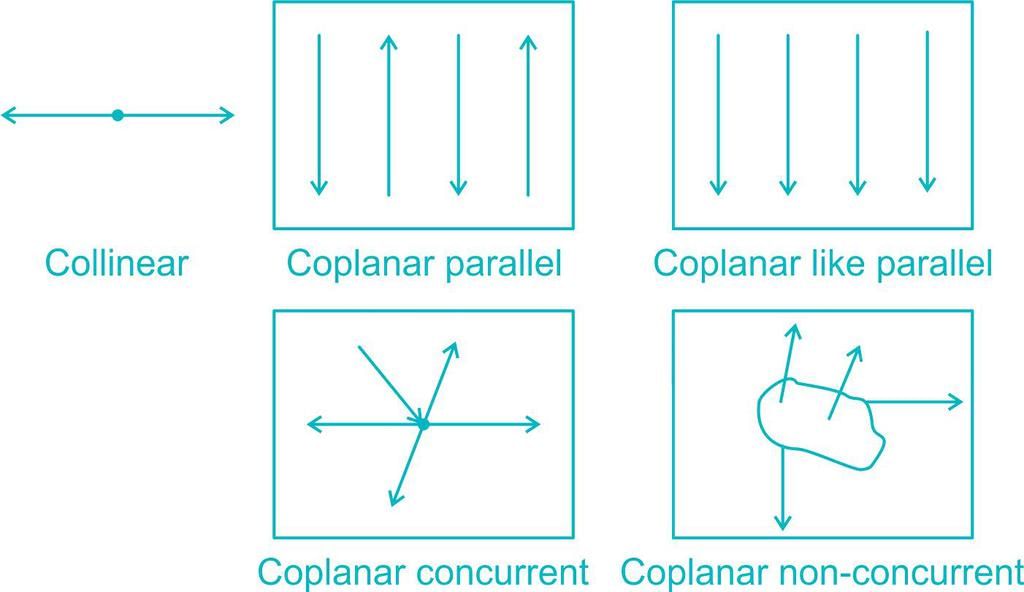
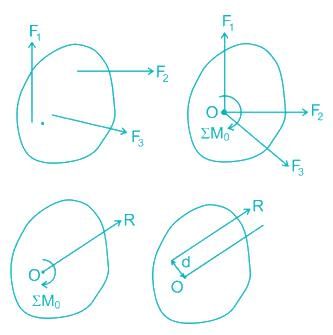

The Result of a non-concurrent force system is the one which will have the same rotational and translatory effect as the given system of forces. It may be a single force, a pure moment of a force and a moment.

When a body is acted upon by a number of coplanar non-concurrent forces. A little consideration will show, that as a result of these forces, the body may have any one of the following states:
1. The body may move in any one direction.
2. The body may rotate about itself without moving.
3. The body may move in any one direction and at the same time, it may also rotate about itself.
4. The body may be completely at rest.
For Equilibrium of coplanar non-concurrent force system:
ΣFx = 0
ΣFy = 0
ΣM = 0
A governor is said to be isochronous when the equilibrium speed is- a)variable for different radii of rotation of governor balls
- b)constant for all radii of rotation of the balls within the working range
- c)constant for particular radii of rotation of governor balls
- d)constant for only one radius of rotation of governor balls
Correct answer is option 'B'. Can you explain this answer?
A governor is said to be isochronous when the equilibrium speed is
a)
variable for different radii of rotation of governor balls
b)
constant for all radii of rotation of the balls within the working range
c)
constant for particular radii of rotation of governor balls
d)
constant for only one radius of rotation of governor balls
|
|
Shubham Sharma answered |
Isochronous governor is a governor that keeps the speed of a prime mover constant at all loads. Also known as a static governor. A governor is said to be isochronous if equilibrium speed is constant for all the radii of rotation in the working range. Therefore, for an isochronous governor the speed range is zero and this type of governor shall maintain constant speed.
Coriolis component of acceleration depends on1. Angular velocity of the link2. Acceleration of the slider3. angular acceleration of the linkWhich of the above is/are correct?- a)1 only
- b)2 only
- c)1 and 3
- d)2 and 3
Correct answer is option 'A'. Can you explain this answer?
Coriolis component of acceleration depends on
1. Angular velocity of the link
2. Acceleration of the slider
3. angular acceleration of the link
Which of the above is/are correct?
a)
1 only
b)
2 only
c)
1 and 3
d)
2 and 3
|
|
Srishti Mukherjee answered |
Coriolis Component of Acceleration
The Coriolis component of acceleration is a result of the rotation of a link in a mechanism. It is important to understand the factors that affect this component of acceleration.
Factors affecting Coriolis Component of Acceleration:
- Angular Velocity of the Link: The Coriolis component of acceleration depends on the angular velocity of the link. The higher the angular velocity, the greater the Coriolis acceleration experienced by the slider.
- Acceleration of the Slider: The acceleration of the slider also plays a role in determining the Coriolis component of acceleration. As the slider moves along the link, its acceleration contributes to the overall Coriolis effect.
- Angular Acceleration of the Link: The angular acceleration of the link is another factor that influences the Coriolis component of acceleration. If the link is accelerating or decelerating, it will affect the Coriolis acceleration experienced by the slider.
Therefore, when considering the Coriolis component of acceleration, it is important to take into account the angular velocity of the link, the acceleration of the slider, and the angular acceleration of the link.
Air at 20°C blows over a hot plate of 50×60 cm made of carbon steel maintained at 220°C. The convective heat transfer coefficient is 25 W/m²K.What will be the heat loss from the plate?- a)1500 W
- b)2500 W
- c)3000 W
- d)4000 W
Correct answer is option 'A'. Can you explain this answer?
Air at 20°C blows over a hot plate of 50×60 cm made of carbon steel maintained at 220°C. The convective heat transfer coefficient is 25 W/m²K.
What will be the heat loss from the plate?
a)
1500 W
b)
2500 W
c)
3000 W
d)
4000 W
|
|
Aditi Khanna answered |
Heat loss from the plate can be calculated using the equation:
Q = h * A * ΔT
Where:
Q is the heat loss
h is the convective heat transfer coefficient
A is the surface area of the plate
ΔT is the temperature difference between the plate and the surrounding air.
Given data:
Air temperature, Ta = 20°C
Plate temperature, Tp = 220°C
Convective heat transfer coefficient, h = 25 W/m²K
Plate dimensions, L = 50 cm, W = 60 cm
First, we need to convert the dimensions of the plate from cm to meters:
L = 50 cm = 0.5 m
W = 60 cm = 0.6 m
Now, we can calculate the surface area of the plate:
A = L * W = 0.5 m * 0.6 m = 0.3 m²
Next, we calculate the temperature difference:
ΔT = Tp - Ta = 220°C - 20°C = 200°C
Now, we can substitute these values into the equation to find the heat loss:
Q = 25 W/m²K * 0.3 m² * 200°C
= 1500 W
Therefore, the heat loss from the plate is 1500 W, which corresponds to option 'A'.
Q = h * A * ΔT
Where:
Q is the heat loss
h is the convective heat transfer coefficient
A is the surface area of the plate
ΔT is the temperature difference between the plate and the surrounding air.
Given data:
Air temperature, Ta = 20°C
Plate temperature, Tp = 220°C
Convective heat transfer coefficient, h = 25 W/m²K
Plate dimensions, L = 50 cm, W = 60 cm
First, we need to convert the dimensions of the plate from cm to meters:
L = 50 cm = 0.5 m
W = 60 cm = 0.6 m
Now, we can calculate the surface area of the plate:
A = L * W = 0.5 m * 0.6 m = 0.3 m²
Next, we calculate the temperature difference:
ΔT = Tp - Ta = 220°C - 20°C = 200°C
Now, we can substitute these values into the equation to find the heat loss:
Q = 25 W/m²K * 0.3 m² * 200°C
= 1500 W
Therefore, the heat loss from the plate is 1500 W, which corresponds to option 'A'.
Function of refrigerants is ?- a)Absorbs heat leakage from surrounding
- b)Absorbs latent heat of vaporization
- c)Both 1 and 2
- d)None of these
Correct answer is option 'C'. Can you explain this answer?
Function of refrigerants is ?
a)
Absorbs heat leakage from surrounding
b)
Absorbs latent heat of vaporization
c)
Both 1 and 2
d)
None of these
|
|
Shubham Sharma answered |
The refrigerant is necessary for the proper functioning of the refrigerator. It absorbs heat leakage and maintains the coolness inside the body of the refrigerator.
Which of the following elements were not found in the form of archaeological remains from Kalibangan?- a)Black bangles
- b)Fire pit
- c)Ploughed field
- d)Couple burial
Correct answer is option 'D'. Can you explain this answer?
Which of the following elements were not found in the form of archaeological remains from Kalibangan?
a)
Black bangles
b)
Fire pit
c)
Ploughed field
d)
Couple burial
|
|
Chirag Kumar answered |
Elements not found in the archaeological remains from Kalibangan:
- Black bangles: Black bangles were found among the archaeological remains from Kalibangan. These bangles were made of terracotta and were a common ornament worn by the people of that time.
- Fire pit: Fire pits were also discovered at Kalibangan. These fire pits were used for various purposes such as cooking, heating, and performing rituals.
- Ploughed field: Ploughed fields were not found in the archaeological remains from Kalibangan. This indicates that agriculture might not have been a significant part of the society at that time.
- Couple burial: Couple burials were not found at Kalibangan. However, single burials were common, suggesting that the society might not have practiced couple burials or that the remains of couple burials have not been discovered yet.
Overall, the archaeological remains from Kalibangan provide valuable insights into the lifestyle, culture, and practices of the people who lived there during that time period.
For quick response of a thermocouple to observe varying temperature of fluids- a)wire diameter must be large
- b)wire material density must be large
- c)wire material specific heat must be large
- d)wire surface heat transfer coefficients must be large
Correct answer is option 'D'. Can you explain this answer?
For quick response of a thermocouple to observe varying temperature of fluids
a)
wire diameter must be large
b)
wire material density must be large
c)
wire material specific heat must be large
d)
wire surface heat transfer coefficients must be large
|
|
Rithika Datta answered |
Quick response of a thermocouple to observe varying temperature of fluids
To ensure a quick response of a thermocouple to observe varying temperature of fluids, the wire surface heat transfer coefficients must be large. Let's understand the significance of each option and why option 'D' is the correct answer.
A) Wire diameter must be large:
- The diameter of the wire does not directly affect the response time of the thermocouple.
- Increasing the wire diameter may improve the mechanical strength of the thermocouple, but it does not enhance its ability to respond quickly to temperature changes.
B) Wire material density must be large:
- The density of the wire material is irrelevant to the response time of the thermocouple.
- Density is a measure of mass per unit volume and does not impact the thermocouple's ability to detect temperature changes quickly.
C) Wire material specific heat must be large:
- Specific heat refers to the amount of heat required to raise the temperature of a substance by a certain amount.
- While specific heat plays a role in heat transfer, it does not directly affect the response time of the thermocouple.
- The specific heat of the wire material does not impact the thermocouple's ability to sense temperature variations in fluids quickly.
D) Wire surface heat transfer coefficients must be large:
- The surface heat transfer coefficient is a measure of the rate at which heat is transferred between a solid surface and a fluid.
- A large surface heat transfer coefficient indicates that heat is transferred more efficiently between the wire surface and the surrounding fluid.
- A thermocouple with a higher surface heat transfer coefficient will respond more quickly to changes in the fluid's temperature.
- This is because the larger heat transfer coefficient facilitates faster heat exchange, allowing the thermocouple to detect temperature variations more rapidly.
Therefore, the correct answer is option 'D' - wire surface heat transfer coefficients must be large in order to ensure a quick response of a thermocouple to observe varying temperature of fluids.
To ensure a quick response of a thermocouple to observe varying temperature of fluids, the wire surface heat transfer coefficients must be large. Let's understand the significance of each option and why option 'D' is the correct answer.
A) Wire diameter must be large:
- The diameter of the wire does not directly affect the response time of the thermocouple.
- Increasing the wire diameter may improve the mechanical strength of the thermocouple, but it does not enhance its ability to respond quickly to temperature changes.
B) Wire material density must be large:
- The density of the wire material is irrelevant to the response time of the thermocouple.
- Density is a measure of mass per unit volume and does not impact the thermocouple's ability to detect temperature changes quickly.
C) Wire material specific heat must be large:
- Specific heat refers to the amount of heat required to raise the temperature of a substance by a certain amount.
- While specific heat plays a role in heat transfer, it does not directly affect the response time of the thermocouple.
- The specific heat of the wire material does not impact the thermocouple's ability to sense temperature variations in fluids quickly.
D) Wire surface heat transfer coefficients must be large:
- The surface heat transfer coefficient is a measure of the rate at which heat is transferred between a solid surface and a fluid.
- A large surface heat transfer coefficient indicates that heat is transferred more efficiently between the wire surface and the surrounding fluid.
- A thermocouple with a higher surface heat transfer coefficient will respond more quickly to changes in the fluid's temperature.
- This is because the larger heat transfer coefficient facilitates faster heat exchange, allowing the thermocouple to detect temperature variations more rapidly.
Therefore, the correct answer is option 'D' - wire surface heat transfer coefficients must be large in order to ensure a quick response of a thermocouple to observe varying temperature of fluids.
Which one of the following statements is correct about an oblique cutting?- a)Direction of chip flow velocity is normal to the cutting edge of the tool
- b)Only two components of cutting forces act on the tool
- c)Cutting edge of the tool is inclined at an acute angle to the direction of tool feed
- d)Cutting edge clears the width of the workpiece
Correct answer is option 'C'. Can you explain this answer?
Which one of the following statements is correct about an oblique cutting?
a)
Direction of chip flow velocity is normal to the cutting edge of the tool
b)
Only two components of cutting forces act on the tool
c)
Cutting edge of the tool is inclined at an acute angle to the direction of tool feed
d)
Cutting edge clears the width of the workpiece
|
|
Tejas Verma answered |
When the relative velocity of the work and the tool is not perpendicular to the cutting edge, such a machining operation is termed as an oblique machining.
The propulsive efficiency of a turbo-jet aircraft approaches 100% when the thrust approaches- a)maximum
- b)50% of the maximum
- c)25% of the maximum
- d)zero
Correct answer is option 'D'. Can you explain this answer?
The propulsive efficiency of a turbo-jet aircraft approaches 100% when the thrust approaches
a)
maximum
b)
50% of the maximum
c)
25% of the maximum
d)
zero
|
|
Sounak Choudhary answered |
Introduction:
The propulsive efficiency of a turbo-jet aircraft is a measure of how effectively it converts fuel energy into useful thrust. It is an important parameter that determines the overall performance of the aircraft. In this question, we are asked to determine at what thrust level the propulsive efficiency of a turbo-jet aircraft approaches 100%.
Explanation:
To understand why the correct answer is option 'D' (zero thrust), let's first understand what propulsive efficiency is and how it is related to thrust.
Propulsive Efficiency:
Propulsive efficiency is defined as the ratio of useful work done (thrust) to the energy input (fuel) required to produce that work. Mathematically, it is given by the equation:
Propulsive Efficiency = Thrust Power / Shaft Power
Thrust Power:
The thrust power is the power generated by the engine to produce the thrust force. It is directly related to the thrust force and the aircraft's velocity. As the thrust force increases, the thrust power also increases.
Shaft Power:
The shaft power is the power generated by the engine to drive the compressor and other accessories. It is the power required to operate the engine itself. The shaft power remains relatively constant regardless of the thrust level.
Relationship between Thrust and Propulsive Efficiency:
The propulsive efficiency of a turbo-jet aircraft is inversely proportional to the thrust. This means that as the thrust force decreases, the propulsive efficiency increases.
Explanation of the Answer:
When the thrust force approaches zero, it means that the engine is not producing any useful work or thrust. In this case, the propulsive efficiency approaches 100% because there is no thrust being produced, but the engine is still consuming fuel to operate.
At zero thrust, the numerator of the propulsive efficiency equation becomes zero, while the denominator (shaft power) remains relatively constant. This results in a propulsive efficiency that approaches 100%.
Therefore, the correct answer is option 'D' (zero thrust) because the propulsive efficiency of a turbo-jet aircraft approaches 100% when there is no thrust being produced.
The propulsive efficiency of a turbo-jet aircraft is a measure of how effectively it converts fuel energy into useful thrust. It is an important parameter that determines the overall performance of the aircraft. In this question, we are asked to determine at what thrust level the propulsive efficiency of a turbo-jet aircraft approaches 100%.
Explanation:
To understand why the correct answer is option 'D' (zero thrust), let's first understand what propulsive efficiency is and how it is related to thrust.
Propulsive Efficiency:
Propulsive efficiency is defined as the ratio of useful work done (thrust) to the energy input (fuel) required to produce that work. Mathematically, it is given by the equation:
Propulsive Efficiency = Thrust Power / Shaft Power
Thrust Power:
The thrust power is the power generated by the engine to produce the thrust force. It is directly related to the thrust force and the aircraft's velocity. As the thrust force increases, the thrust power also increases.
Shaft Power:
The shaft power is the power generated by the engine to drive the compressor and other accessories. It is the power required to operate the engine itself. The shaft power remains relatively constant regardless of the thrust level.
Relationship between Thrust and Propulsive Efficiency:
The propulsive efficiency of a turbo-jet aircraft is inversely proportional to the thrust. This means that as the thrust force decreases, the propulsive efficiency increases.
Explanation of the Answer:
When the thrust force approaches zero, it means that the engine is not producing any useful work or thrust. In this case, the propulsive efficiency approaches 100% because there is no thrust being produced, but the engine is still consuming fuel to operate.
At zero thrust, the numerator of the propulsive efficiency equation becomes zero, while the denominator (shaft power) remains relatively constant. This results in a propulsive efficiency that approaches 100%.
Therefore, the correct answer is option 'D' (zero thrust) because the propulsive efficiency of a turbo-jet aircraft approaches 100% when there is no thrust being produced.
What is the pressure difference between inside and outside of a droplet of water?Where σ is surface tension and d is the diameter of the droplet.- a)2σ/d
- b)4σ/d
- c)8σ/d
- d)12σ/d
Correct answer is option 'B'. Can you explain this answer?
What is the pressure difference between inside and outside of a droplet of water?
Where σ is surface tension and d is the diameter of the droplet.
a)
2σ/d
b)
4σ/d
c)
8σ/d
d)
12σ/d
|
|
Gaurav Chavan answered |
Pressure difference inside and outside a droplet of water
Pressure inside a droplet of water is higher than the pressure outside due to the surface tension of the water.
Formula
The pressure difference can be calculated using the formula: ΔP = 2σ/d, where σ is the surface tension and d is the diameter of the droplet.
Explanation
- Inside the droplet, the water molecules are attracted to each other due to surface tension, creating a higher pressure.
- Outside the droplet, the water molecules are not being pulled in all directions, resulting in a lower pressure.
- The pressure difference is directly proportional to the surface tension and inversely proportional to the diameter of the droplet.
Correct answer
The correct answer is option B, 4σ/d, as the pressure difference is twice the surface tension divided by the diameter of the droplet.
Pressure inside a droplet of water is higher than the pressure outside due to the surface tension of the water.
Formula
The pressure difference can be calculated using the formula: ΔP = 2σ/d, where σ is the surface tension and d is the diameter of the droplet.
Explanation
- Inside the droplet, the water molecules are attracted to each other due to surface tension, creating a higher pressure.
- Outside the droplet, the water molecules are not being pulled in all directions, resulting in a lower pressure.
- The pressure difference is directly proportional to the surface tension and inversely proportional to the diameter of the droplet.
Correct answer
The correct answer is option B, 4σ/d, as the pressure difference is twice the surface tension divided by the diameter of the droplet.
The effect of increasing the stiffness of springs of centrifugal clutch is- a)The decrease of engagement speed
- b)The increase of engagement speed
- c)The increase of frictional force at maximum speed
- d)None of the above
Correct answer is option 'B'. Can you explain this answer?
The effect of increasing the stiffness of springs of centrifugal clutch is
a)
The decrease of engagement speed
b)
The increase of engagement speed
c)
The increase of frictional force at maximum speed
d)
None of the above
|
|
Mita Mehta answered |
When the load is released from the clutch lever, it again engages with the shaft. As the stiffness of spring increases, the restoring force on the clutch will increase and hence velocity of engagement will be more.
A cylindrical steel pressure vessel 400 mm in diameter with a wall thickness of 20 mm, is subjected to an internal pressure of 4.5 MPa. Calculate the circumferential stresses (σx ) and longitudinal stresses (σy ) in the steel vessel.- a)σx = 45 MPa, σy = 22.5 MPa
- b)σx = 22.5 MPa, σy = 45 MPa
- c)σx = 45 MPa, σy = 90 MPa
- d)σx = 90 MPa, σy = 45 MPa
Correct answer is option 'A'. Can you explain this answer?
A cylindrical steel pressure vessel 400 mm in diameter with a wall thickness of 20 mm, is subjected to an internal pressure of 4.5 MPa. Calculate the circumferential stresses (σx ) and longitudinal stresses (σy ) in the steel vessel.
a)
σx = 45 MPa, σy = 22.5 MPa
b)
σx = 22.5 MPa, σy = 45 MPa
c)
σx = 45 MPa, σy = 90 MPa
d)
σx = 90 MPa, σy = 45 MPa
|
|
Shubham Sharma answered |
Concept
For thin cylindrical vessel:
Hoop/circumferential stress, 

Longitudinal stress, 

For thin spherical vessel:
Hoop stress/Longitudinal stress:

Calculation:
d = 400 mm, t = 20 mm, p = 4.5 MPa

Which weed is widely used to reduce water pollution caused by industries effluents?- a)Bermuda Grass
- b)Pigweed
- c)Elephant Grass
- d)Eichhornia
Correct answer is option 'C'. Can you explain this answer?
Which weed is widely used to reduce water pollution caused by industries effluents?
a)
Bermuda Grass
b)
Pigweed
c)
Elephant Grass
d)
Eichhornia
|
|
Mita Mehta answered |
Elephant Grass is a common weed i.e. widely used to reduce water pollution caused by industries effluents. It has several environmental impacts like prevention from soil erosion, it acts as pest control agent etc.
For the same type of shapes, the value of Radiation Shape Factor will be higher when surfaces are- a)More closer only
- b)Moved further apart
- c)Smaller and held closer
- d)Larger and held closer
Correct answer is option 'D'. Can you explain this answer?
For the same type of shapes, the value of Radiation Shape Factor will be higher when surfaces are
a)
More closer only
b)
Moved further apart
c)
Smaller and held closer
d)
Larger and held closer
|
|
Kavya Basu answered |
Explanation:
Radiation shape factor, also known as view factor or form factor, is a dimensionless quantity that describes the radiative exchange between two surfaces. It represents the fraction of the radiation leaving one surface that is intercepted by another surface.
The value of radiation shape factor depends on the geometry and orientation of the surfaces. In this case, we are considering the same type of shapes, so we can assume that the surfaces have similar dimensions and shapes.
Surface Area:
The surface area of a shape determines the amount of radiation that can be emitted or absorbed by that surface. A larger surface area means more radiation exchange between the surfaces. Therefore, for the same type of shapes, the value of the radiation shape factor will be higher when the surfaces have a larger area.
Distance between Surfaces:
The distance between the surfaces also affects the radiation shape factor. When the surfaces are closer together, there is a higher probability of radiation emitted by one surface being intercepted by the other surface. This increases the radiation shape factor. On the other hand, when the surfaces are moved further apart, the probability of interception decreases, resulting in a lower radiation shape factor.
Combining Surface Area and Distance:
When both surface area and distance are considered together, we can determine the optimal conditions for a higher radiation shape factor. In this case, when the surfaces are larger and held closer, the radiation shape factor will be higher.
Conclusion:
The correct answer is option 'D' - Larger and held closer. The value of the radiation shape factor will be higher when the surfaces are larger and held closer to each other. This leads to a greater exchange of radiation between the surfaces.
Radiation shape factor, also known as view factor or form factor, is a dimensionless quantity that describes the radiative exchange between two surfaces. It represents the fraction of the radiation leaving one surface that is intercepted by another surface.
The value of radiation shape factor depends on the geometry and orientation of the surfaces. In this case, we are considering the same type of shapes, so we can assume that the surfaces have similar dimensions and shapes.
Surface Area:
The surface area of a shape determines the amount of radiation that can be emitted or absorbed by that surface. A larger surface area means more radiation exchange between the surfaces. Therefore, for the same type of shapes, the value of the radiation shape factor will be higher when the surfaces have a larger area.
Distance between Surfaces:
The distance between the surfaces also affects the radiation shape factor. When the surfaces are closer together, there is a higher probability of radiation emitted by one surface being intercepted by the other surface. This increases the radiation shape factor. On the other hand, when the surfaces are moved further apart, the probability of interception decreases, resulting in a lower radiation shape factor.
Combining Surface Area and Distance:
When both surface area and distance are considered together, we can determine the optimal conditions for a higher radiation shape factor. In this case, when the surfaces are larger and held closer, the radiation shape factor will be higher.
Conclusion:
The correct answer is option 'D' - Larger and held closer. The value of the radiation shape factor will be higher when the surfaces are larger and held closer to each other. This leads to a greater exchange of radiation between the surfaces.
In a multi cylinder engine, what does firing order mean?- a)Sequence of valves operating
- b)Sequence of the Power stroke
- c)Sequence of Suction stroke
- d)Sequence of the exhaust stroke
Correct answer is option 'B'. Can you explain this answer?
In a multi cylinder engine, what does firing order mean?
a)
Sequence of valves operating
b)
Sequence of the Power stroke
c)
Sequence of Suction stroke
d)
Sequence of the exhaust stroke
|
|
Tejas Verma answered |
Firing order means the sequence in which the cylinders generate power stroke in multi cylinder engines. This firing order is achieved by placing the spark plug according to the desired firing order. Correct firing order is necessary to achieve smooth running of the engine, less vibration and correct engine balance.
What is the velocity of sound waves in the fluid with K as the bulk modulus and p as the density of the fluid?- a)K p
- b)p K
- c)K pg
- d)K gp
Correct answer is option 'A'. Can you explain this answer?
What is the velocity of sound waves in the fluid with K as the bulk modulus and p as the density of the fluid?
a)
K p
b)
p K
c)
K pg
d)
K gp
|
|
Mita Mehta answered |
The velocity of sound waves in the fluid with K as the bulk modulus and p as the density of the fluid is given by K p
What is the instrument used for the automatic control scheme during the fluid flow?- a)Rotameters
- b)Pulley plates
- c)Rotary Piston
- d)Pilot Static Tube
Correct answer is option 'D'. Can you explain this answer?
What is the instrument used for the automatic control scheme during the fluid flow?
a)
Rotameters
b)
Pulley plates
c)
Rotary Piston
d)
Pilot Static Tube
|
|
Shubham Sharma answered |
Pilot static tube is a system that uses an automatic control scheme to detect pressure. It has several holes connected to one side of the device. These outside holes are called a pressure transducer, which controls the automatic scheme during fluid flow.
The degree of reaction of a steam turbine is the ratio between the enthalpy drops in- a)in the nozzle and that in the stage
- b)moving blades and that in the stage
- c)moving blades and that in the nozzle
- d)in the nozzle and that in the moving blades
Correct answer is option 'B'. Can you explain this answer?
The degree of reaction of a steam turbine is the ratio between the enthalpy drops in
a)
in the nozzle and that in the stage
b)
moving blades and that in the stage
c)
moving blades and that in the nozzle
d)
in the nozzle and that in the moving blades
|
|
Mayank Mukherjee answered |
Explanation:
The degree of reaction of a steam turbine is a measure of how the enthalpy drop is distributed between the moving blades and the nozzle in a turbine stage. It is defined as the ratio between the enthalpy drop in the moving blades and the enthalpy drop in the stage.
a) Enthalpy drop in the nozzle:
The nozzle is the first component in a steam turbine where the steam expands and gains velocity. As the steam passes through the nozzle, its pressure and temperature decrease while its velocity increases. This decrease in pressure and temperature corresponds to an enthalpy drop. This enthalpy drop in the nozzle is denoted by ΔH_n.
b) Enthalpy drop in the moving blades:
The moving blades are the components in a steam turbine that extract energy from the steam as it passes through them. The steam's velocity decreases while its pressure and temperature remain relatively constant. This decrease in velocity and corresponding increase in pressure and temperature corresponds to an enthalpy drop. This enthalpy drop in the moving blades is denoted by ΔH_m.
c) Enthalpy drop in the stage:
The stage in a steam turbine refers to the combination of the nozzle and the moving blades. The stage as a whole is responsible for extracting energy from the steam and converting it into mechanical work. The enthalpy drop in the stage is the sum of the enthalpy drops in the nozzle and the moving blades, and it is denoted by ΔH_s.
Degree of reaction:
The degree of reaction (R) is calculated as the ratio between the enthalpy drop in the moving blades (ΔH_m) and the enthalpy drop in the stage (ΔH_s).
R = ΔH_m / ΔH_s
Since the enthalpy drop in the stage (ΔH_s) is equal to the sum of the enthalpy drops in the nozzle (ΔH_n) and the moving blades (ΔH_m), the ratio can be simplified as:
R = ΔH_m / (ΔH_n + ΔH_m)
Therefore, the correct answer is option 'B', which states that the degree of reaction is the ratio between the enthalpy drops in the moving blades and that in the stage.
The degree of reaction of a steam turbine is a measure of how the enthalpy drop is distributed between the moving blades and the nozzle in a turbine stage. It is defined as the ratio between the enthalpy drop in the moving blades and the enthalpy drop in the stage.
a) Enthalpy drop in the nozzle:
The nozzle is the first component in a steam turbine where the steam expands and gains velocity. As the steam passes through the nozzle, its pressure and temperature decrease while its velocity increases. This decrease in pressure and temperature corresponds to an enthalpy drop. This enthalpy drop in the nozzle is denoted by ΔH_n.
b) Enthalpy drop in the moving blades:
The moving blades are the components in a steam turbine that extract energy from the steam as it passes through them. The steam's velocity decreases while its pressure and temperature remain relatively constant. This decrease in velocity and corresponding increase in pressure and temperature corresponds to an enthalpy drop. This enthalpy drop in the moving blades is denoted by ΔH_m.
c) Enthalpy drop in the stage:
The stage in a steam turbine refers to the combination of the nozzle and the moving blades. The stage as a whole is responsible for extracting energy from the steam and converting it into mechanical work. The enthalpy drop in the stage is the sum of the enthalpy drops in the nozzle and the moving blades, and it is denoted by ΔH_s.
Degree of reaction:
The degree of reaction (R) is calculated as the ratio between the enthalpy drop in the moving blades (ΔH_m) and the enthalpy drop in the stage (ΔH_s).
R = ΔH_m / ΔH_s
Since the enthalpy drop in the stage (ΔH_s) is equal to the sum of the enthalpy drops in the nozzle (ΔH_n) and the moving blades (ΔH_m), the ratio can be simplified as:
R = ΔH_m / (ΔH_n + ΔH_m)
Therefore, the correct answer is option 'B', which states that the degree of reaction is the ratio between the enthalpy drops in the moving blades and that in the stage.
What is the principal cause of action of buoyant force on a body submerged partially or fully in fluid?- a)Displacement of fluid due to submerged body
- b)Development of force due to dynamic action
- c)Internal shear forces mitigating external forces
- d)None of the mentioned
Correct answer is option 'A'. Can you explain this answer?
What is the principal cause of action of buoyant force on a body submerged partially or fully in fluid?
a)
Displacement of fluid due to submerged body
b)
Development of force due to dynamic action
c)
Internal shear forces mitigating external forces
d)
None of the mentioned
|
|
Priya Kumar answered |
Buoyant force is the upward force exerted by a fluid on a body that is partially or fully submerged in it. The principal cause of this force can be explained by the concept of displacement of fluid.
Displacement of Fluid:
When a body is partially or fully submerged in a fluid, it displaces some amount of fluid. The displaced fluid moves out of the way to accommodate the presence of the body. This displacement of fluid creates a void or empty space in the fluid where the body is located.
Archimedes' Principle:
According to Archimedes' principle, the buoyant force experienced by a body submerged in a fluid is equal to the weight of the fluid displaced by the body. This principle explains that the buoyant force is directly proportional to the volume of the displaced fluid.
Explanation:
The principal cause of action of buoyant force is the displacement of fluid due to the submerged body. When a body is submerged in a fluid, it displaces a certain volume of fluid equal to its own volume. This displacement creates a void in the fluid, which is then filled by the surrounding fluid.
The displaced fluid exerts an upward force on the body, which is the buoyant force. This force is exerted in the opposite direction to the force of gravity acting on the body. As a result, the body experiences an upward force that opposes its weight, making it feel lighter in the fluid.
The magnitude of the buoyant force depends on the volume of the displaced fluid and the density of the fluid. A denser fluid will exert a greater buoyant force compared to a less dense fluid, provided the volume of the displaced fluid remains the same.
In conclusion, the principal cause of action of buoyant force on a body submerged partially or fully in a fluid is the displacement of fluid due to the presence of the body. This displacement creates a void or empty space in the fluid, which is then filled by the surrounding fluid, exerting an upward force on the body known as the buoyant force.
Displacement of Fluid:
When a body is partially or fully submerged in a fluid, it displaces some amount of fluid. The displaced fluid moves out of the way to accommodate the presence of the body. This displacement of fluid creates a void or empty space in the fluid where the body is located.
Archimedes' Principle:
According to Archimedes' principle, the buoyant force experienced by a body submerged in a fluid is equal to the weight of the fluid displaced by the body. This principle explains that the buoyant force is directly proportional to the volume of the displaced fluid.
Explanation:
The principal cause of action of buoyant force is the displacement of fluid due to the submerged body. When a body is submerged in a fluid, it displaces a certain volume of fluid equal to its own volume. This displacement creates a void in the fluid, which is then filled by the surrounding fluid.
The displaced fluid exerts an upward force on the body, which is the buoyant force. This force is exerted in the opposite direction to the force of gravity acting on the body. As a result, the body experiences an upward force that opposes its weight, making it feel lighter in the fluid.
The magnitude of the buoyant force depends on the volume of the displaced fluid and the density of the fluid. A denser fluid will exert a greater buoyant force compared to a less dense fluid, provided the volume of the displaced fluid remains the same.
In conclusion, the principal cause of action of buoyant force on a body submerged partially or fully in a fluid is the displacement of fluid due to the presence of the body. This displacement creates a void or empty space in the fluid, which is then filled by the surrounding fluid, exerting an upward force on the body known as the buoyant force.
What type of liquids are measured using a manometer?- a)Heavy liquids
- b)Medium Liquids
- c)Light Liquids
- d)Heavy and light liquids
Correct answer is option 'C'. Can you explain this answer?
What type of liquids are measured using a manometer?
a)
Heavy liquids
b)
Medium Liquids
c)
Light Liquids
d)
Heavy and light liquids
|
|
Shubham Sharma answered |
Measurement of liquid in a manometer takes place through differential pressures by balancing the weight. Thus, it is easier for the manometer to measure liquids of lesser density than the heavier ones. Example of a light liquid is Water.
Choose the correct option which indicates the objective of the Morse test.- a)Indicated power of multi-cylinder engine
- b)Indicated power of single cylinder diesel engine
- c)Performance of a single cylinder petrol engine
- d)None of these
Correct answer is option 'A'. Can you explain this answer?
Choose the correct option which indicates the objective of the Morse test.
a)
Indicated power of multi-cylinder engine
b)
Indicated power of single cylinder diesel engine
c)
Performance of a single cylinder petrol engine
d)
None of these
|
|
Ishaan Unni answered |
Understanding the Morse Test
The Morse test is a vital procedure utilized in the field of engine testing, specifically for multi-cylinder engines. The objective of this test is to determine the indicated power of a multi-cylinder engine through a series of measurements and calculations.
Key Objectives of the Morse Test:
- Indicated Power Measurement:
- The primary intention of the Morse test is to calculate the indicated power, which reflects the engine's theoretical power output without accounting for losses due to friction and heat.
- Multi-Cylinder Engine Focus:
- The test is designed specifically for multi-cylinder engines, allowing engineers to assess the performance and efficiency of these engines in a comprehensive manner.
- Data Collection:
- During the test, data is collected regarding pressure and volume changes within the engine’s cylinders, facilitating accurate calculations of the indicated power.
Why Option A is Correct:
- The correct option is 'A' because the Morse test has been specifically developed and validated to assess the performance of multi-cylinder engines.
- Options B and C, which refer to single-cylinder engines (diesel and petrol), are not accurate as the Morse test does not focus on these types.
Conclusion:
In summary, the Morse test serves as a crucial tool for evaluating the indicated power of multi-cylinder engines, offering insights into their performance characteristics and efficiency. This makes option 'A' the correct answer in the context of the Morse test objectives.
The Morse test is a vital procedure utilized in the field of engine testing, specifically for multi-cylinder engines. The objective of this test is to determine the indicated power of a multi-cylinder engine through a series of measurements and calculations.
Key Objectives of the Morse Test:
- Indicated Power Measurement:
- The primary intention of the Morse test is to calculate the indicated power, which reflects the engine's theoretical power output without accounting for losses due to friction and heat.
- Multi-Cylinder Engine Focus:
- The test is designed specifically for multi-cylinder engines, allowing engineers to assess the performance and efficiency of these engines in a comprehensive manner.
- Data Collection:
- During the test, data is collected regarding pressure and volume changes within the engine’s cylinders, facilitating accurate calculations of the indicated power.
Why Option A is Correct:
- The correct option is 'A' because the Morse test has been specifically developed and validated to assess the performance of multi-cylinder engines.
- Options B and C, which refer to single-cylinder engines (diesel and petrol), are not accurate as the Morse test does not focus on these types.
Conclusion:
In summary, the Morse test serves as a crucial tool for evaluating the indicated power of multi-cylinder engines, offering insights into their performance characteristics and efficiency. This makes option 'A' the correct answer in the context of the Morse test objectives.
In a centrifugal compressor, an increase in speed at a given pressure ratio causes- a)increase inflow and increase in efficiency
- b)increase in flow and decrease in efficiency
- c)decrease in flow and increase in efficiency
- d)decrease in flow and decrease in efficiency
Correct answer is option 'B'. Can you explain this answer?
In a centrifugal compressor, an increase in speed at a given pressure ratio causes
a)
increase inflow and increase in efficiency
b)
increase in flow and decrease in efficiency
c)
decrease in flow and increase in efficiency
d)
decrease in flow and decrease in efficiency
|
|
Shubham Sharma answered |
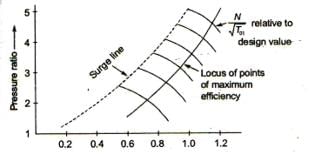
In the SI engine, highest UBHC (Unburnt Hydrocarbon) concentration is observed during- a)Maximum load
- b)Acceleration
- c)Deceleration
- d)Idling
Correct answer is option 'C'. Can you explain this answer?
In the SI engine, highest UBHC (Unburnt Hydrocarbon) concentration is observed during
a)
Maximum load
b)
Acceleration
c)
Deceleration
d)
Idling
|
|
Mita Mehta answered |
Highest unburnt hydrocarbon concentration is observed during declaration.
Which one of the following is a gravity controlled type governor?- a)Hartnell governor
- b)Hartung governor
- c)Watt governor
- d)Pickering governor
Correct answer is option 'C'. Can you explain this answer?
Which one of the following is a gravity controlled type governor?
a)
Hartnell governor
b)
Hartung governor
c)
Watt governor
d)
Pickering governor
|
|
Tejas Verma answered |
Watt, Porter and Proell governor are under the category of gravity controlled type governor.
In a variable speed SI engine, the maximum torque occurs at the maximum- a)Speed
- b)Brake power
- c)Indicated power
- d)Volumetric efficiency
Correct answer is option 'B'. Can you explain this answer?
In a variable speed SI engine, the maximum torque occurs at the maximum
a)
Speed
b)
Brake power
c)
Indicated power
d)
Volumetric efficiency
|
|
Tejas Verma answered |
Brake Power = 2?NT/60
N = speed in rpm
T = torque
Plug weld joint is used- a)where longitudinal shear is present
- b)where severe loading is encountered and the upper surfaces of both pieces must be in the same plane
- c)to join two pieces of metal in the same manner as rivet joint metals
- d)there is nothing like plug weld joint
Correct answer is option 'C'. Can you explain this answer?
Plug weld joint is used
a)
where longitudinal shear is present
b)
where severe loading is encountered and the upper surfaces of both pieces must be in the same plane
c)
to join two pieces of metal in the same manner as rivet joint metals
d)
there is nothing like plug weld joint
|
|
Mita Mehta answered |
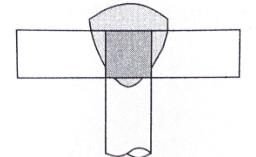
Plug weld joint is used to join two pieces of metal in the same manner as riveted joint metals.
In a close system, heat transfer at constant volume- a)will increase the pressure
- b)will increase the internal energy
- c)both a and b
- d)None of these
Correct answer is option 'B'. Can you explain this answer?
In a close system, heat transfer at constant volume
a)
will increase the pressure
b)
will increase the internal energy
c)
both a and b
d)
None of these
|
|
Sagar Basu answered |
Constant Volume Heat Transfer in a Closed System
Heat transfer at constant volume in a closed system will increase the internal energy of the system. This is because when heat is added to a system at constant volume, the energy is used to increase the internal energy of the system rather than doing work on the surroundings.
Explanation:
Constant Volume Process:
- In a constant volume process, the volume of the system remains constant, which means no work is done by the system.
- This implies that any heat added to the system will solely increase the internal energy of the system.
Internal Energy:
- Internal energy is the sum of the kinetic and potential energies of the particles within a system.
- When heat is transferred to a system at constant volume, the internal energy of the system increases as the kinetic energy of the particles increases.
Pressure and Volume Relationship:
- In a closed system at constant volume, the pressure will not increase directly due to heat transfer.
- If the volume remains constant, the pressure will not change even when heat is added, as pressure is dependent on volume in a closed system.
Therefore, in a closed system with constant volume, heat transfer will increase the internal energy of the system without affecting the pressure.
Heat transfer at constant volume in a closed system will increase the internal energy of the system. This is because when heat is added to a system at constant volume, the energy is used to increase the internal energy of the system rather than doing work on the surroundings.
Explanation:
Constant Volume Process:
- In a constant volume process, the volume of the system remains constant, which means no work is done by the system.
- This implies that any heat added to the system will solely increase the internal energy of the system.
Internal Energy:
- Internal energy is the sum of the kinetic and potential energies of the particles within a system.
- When heat is transferred to a system at constant volume, the internal energy of the system increases as the kinetic energy of the particles increases.
Pressure and Volume Relationship:
- In a closed system at constant volume, the pressure will not increase directly due to heat transfer.
- If the volume remains constant, the pressure will not change even when heat is added, as pressure is dependent on volume in a closed system.
Therefore, in a closed system with constant volume, heat transfer will increase the internal energy of the system without affecting the pressure.
Stress concentration is caused due to- a)variation in properties of the material from point to point in a member
- b)pitting at points or areas at which loads on a member are applied
- c)abrupt change of section
- d)all of the above
Correct answer is option 'D'. Can you explain this answer?
Stress concentration is caused due to
a)
variation in properties of the material from point to point in a member
b)
pitting at points or areas at which loads on a member are applied
c)
abrupt change of section
d)
all of the above
|
|
Tejas Verma answered |
Stress concentration is the localized stress considerably higher than average, even in a uniformly loaded cross-section of uniform thickness due to abrupt change in the geometry or localised loading. The stress concentration factor is not considered harmful for ductile materials in static loading because of local yielding in ductile materials when relieving the stress concentration. When the stress in the vicinity of the discontinuity reaches the yield point, plastic deformation results in the redistribution of stresses. This plastic deformation prevents the harmful effects of stress concentration in ductile materials.
While in Brittle materials, stress concentration factor is important in both static and dynamic loading. Brittle materials fail due to fracture. So there is little deformation to relax the concentrated stresses and thus has damaging effects.
Which of the following factors would increase the probability of knocking in the CI engines?1. Long ignition delay of fuel.2. Low self ignition temperature of fuel.3. Low volatility of fuel.Select the correct answer using the codes given below:Codes:- a)1, 2 and 3
- b)1 and 2
- c)1 and 3
- d)2 and 3
Correct answer is option 'C'. Can you explain this answer?
Which of the following factors would increase the probability of knocking in the CI engines?
1. Long ignition delay of fuel.
2. Low self ignition temperature of fuel.
3. Low volatility of fuel.
Select the correct answer using the codes given below:
Codes:
a)
1, 2 and 3
b)
1 and 2
c)
1 and 3
d)
2 and 3
|
|
Tejas Verma answered |
In CI engine long ignition delay leads to knocking.
Two forces act at an angle of 120°. If the greater force is 50 N and their resultant is perpendicular to the smaller force, the smaller force is _________N.- a)20
- b)25
- c)30
- d)35
Correct answer is option 'B'. Can you explain this answer?
Two forces act at an angle of 120°. If the greater force is 50 N and their resultant is perpendicular to the smaller force, the smaller force is _________N.
a)
20
b)
25
c)
30
d)
35
|
|
Advait Dasgupta answered |
If two forces act at an angle of 120 degrees, we can use vector addition to find the resultant force.
Let's call the two forces F1 and F2.
To find the resultant force, we can break down each force into its horizontal and vertical components.
F1 can be broken down into F1x and F1y, and F2 can be broken down into F2x and F2y.
The horizontal component of F1, F1x, can be found using the formula F1x = F1 * cos(120), where 120 is the angle between the force and the x-axis.
Similarly, the vertical component of F1, F1y, can be found using the formula F1y = F1 * sin(120).
We can do the same for F2. The horizontal component of F2, F2x, can be found using the formula F2x = F2 * cos(120), and the vertical component of F2, F2y, can be found using the formula F2y = F2 * sin(120).
Now, we can add the horizontal components and vertical components separately to find the resultant force.
The horizontal component of the resultant force, Fx, can be found by adding F1x and F2x: Fx = F1x + F2x.
The vertical component of the resultant force, Fy, can be found by adding F1y and F2y: Fy = F1y + F2y.
Finally, we can find the magnitude and direction of the resultant force using the formulas:
Magnitude of the resultant force, F = sqrt(Fx^2 + Fy^2).
Direction of the resultant force, θ = arctan(Fy/Fx).
Note that the angles should be in radians for the trigonometric functions. If you have the angles in degrees, you can convert them to radians by multiplying by π/180.
Keep in mind that the direction of the resultant force is measured from the positive x-axis.
I hope this helps! Let me know if you have any further questions.
Let's call the two forces F1 and F2.
To find the resultant force, we can break down each force into its horizontal and vertical components.
F1 can be broken down into F1x and F1y, and F2 can be broken down into F2x and F2y.
The horizontal component of F1, F1x, can be found using the formula F1x = F1 * cos(120), where 120 is the angle between the force and the x-axis.
Similarly, the vertical component of F1, F1y, can be found using the formula F1y = F1 * sin(120).
We can do the same for F2. The horizontal component of F2, F2x, can be found using the formula F2x = F2 * cos(120), and the vertical component of F2, F2y, can be found using the formula F2y = F2 * sin(120).
Now, we can add the horizontal components and vertical components separately to find the resultant force.
The horizontal component of the resultant force, Fx, can be found by adding F1x and F2x: Fx = F1x + F2x.
The vertical component of the resultant force, Fy, can be found by adding F1y and F2y: Fy = F1y + F2y.
Finally, we can find the magnitude and direction of the resultant force using the formulas:
Magnitude of the resultant force, F = sqrt(Fx^2 + Fy^2).
Direction of the resultant force, θ = arctan(Fy/Fx).
Note that the angles should be in radians for the trigonometric functions. If you have the angles in degrees, you can convert them to radians by multiplying by π/180.
Keep in mind that the direction of the resultant force is measured from the positive x-axis.
I hope this helps! Let me know if you have any further questions.
Which of the following channels separates Amino dive from Lakshadweep?- a)7 Degree channel
- b)8 Degree channel
- c)9 Degree channel
- d)10 Degree channel
Correct answer is option 'A'. Can you explain this answer?
Which of the following channels separates Amino dive from Lakshadweep?
a)
7 Degree channel
b)
8 Degree channel
c)
9 Degree channel
d)
10 Degree channel
|
|
Shubham Sharma answered |
The Laccadive Islands or Cannanore Islands are one of the three island subgroups in the Union Territory of Lakshadweep. 7 Degree channel separates Amino dive from Laccadive, while 8 degree channel separates the Maldives from Lakshadweep.
Which statement(s) is/are CORRECT regarding Dalton’s Atomic theory?I. All matters are made of very tiny particles.II. Atoms of different elements have different masses and chemical properties.III. The relative number of atoms is variable in any compound.- a)Only I and II
- b)Only I and III
- c)Only II and III
- d)All I, II and III
Correct answer is option 'A'. Can you explain this answer?
Which statement(s) is/are CORRECT regarding Dalton’s Atomic theory?
I. All matters are made of very tiny particles.
II. Atoms of different elements have different masses and chemical properties.
III. The relative number of atoms is variable in any compound.
a)
Only I and II
b)
Only I and III
c)
Only II and III
d)
All I, II and III
|
|
Rajesh Khanna answered |
Dalton's atomic theory proposed that all matter was composed of atoms, indivisible and indestructible building blocks. While all atoms of an element were identical, different elements had atoms of differing size and mass.
The pressure inside a soap bubble of 50 mm diameter is 25 N/m² above the atmospheric pressure. The surface tension in soap film would be- a)0.156 N/m
- b)0.312 N/m
- c)0.624 N/m
- d)0.078 N/m
Correct answer is option 'A'. Can you explain this answer?
The pressure inside a soap bubble of 50 mm diameter is 25 N/m² above the atmospheric pressure. The surface tension in soap film would be
a)
0.156 N/m
b)
0.312 N/m
c)
0.624 N/m
d)
0.078 N/m
|
|
Mita Mehta answered |
Pressure intensity inside a soap bubble,
p = 4? /r
? = pr/4 = 25 x 25 x 10-¾
= 0.15625 N/m
Maximum intensity of pressure can be calculated by ?- a)C/R
- b)C/R2
- c)C/r2
- d)C/r3
Correct answer is option 'C'. Can you explain this answer?
Maximum intensity of pressure can be calculated by ?
a)
C/R
b)
C/R2
c)
C/r2
d)
C/r3
|
|
Mita Mehta answered |
We have standard formulas for pressure intensity as
Pmax x r2 = C
Air injection in IC engine refers to the njection of- a)Air only
- b)Liquid fuel only
- c)Liquid fuel and air
- d)Supercharging air
Correct answer is option 'C'. Can you explain this answer?
Air injection in IC engine refers to the njection of
a)
Air only
b)
Liquid fuel only
c)
Liquid fuel and air
d)
Supercharging air
|
|
Tejas Verma answered |
Air injection in IC engines refers to the injection of liquid fuel and air.
In nuclear reactors, cadmium rods are used as which of the following?- a)Fuel
- b)Moderator
- c)Controller
- d)Lubricant
Correct answer is option 'C'. Can you explain this answer?
In nuclear reactors, cadmium rods are used as which of the following?
a)
Fuel
b)
Moderator
c)
Controller
d)
Lubricant
|
|
Tejas Verma answered |
In nuclear reactors, cadmium rods are used as Controllers. Control rods are used in nuclear reactors to control the fission rate of uranium and plutonium. They are composed of chemical elements such as boron, silver, indium and cadmium that are capable of absorbing many neutrons without fissioning themselves.
A metal sulphate's chemical formula MSO4 . A chloride of the same metal will have the formula.- a)M2Cl3
- b)M2Cl
- c)MCl2
- d)M3C3
Correct answer is option 'C'. Can you explain this answer?
A metal sulphate's chemical formula MSO4 . A chloride of the same metal will have the formula.
a)
M2Cl3
b)
M2Cl
c)
MCl2
d)
M3C3
|
|
Shubham Sharma answered |
The chemical formula of metal sulphate is MSO4 as the valency of the metal M++ will be 2 as the valency of SO4-- is 2. The chemical formula of its chloride(Cl2-- ) of the metal is MCl2 .
In a single-stage open-cycle gas turbine, the mass flow through the turbine is higher than the mass flows through compressor because- a)the specific volume of air increases by the use of an intercooler
- b)the temperature of air increases in the reheater
- c)the combustion of fuel takes place in the combustion chamber
- d)the specific heats at a constant pressure of incoming air and exhaust gases are different
Correct answer is option 'C'. Can you explain this answer?
In a single-stage open-cycle gas turbine, the mass flow through the turbine is higher than the mass flows through compressor because
a)
the specific volume of air increases by the use of an intercooler
b)
the temperature of air increases in the reheater
c)
the combustion of fuel takes place in the combustion chamber
d)
the specific heats at a constant pressure of incoming air and exhaust gases are different
|
|
Raghavendra Nambiar answered |
Understanding Mass Flow in Gas Turbines
In a single-stage open-cycle gas turbine, the mass flow through the turbine is indeed higher than that through the compressor. This phenomenon is primarily explained by the combustion process occurring in the combustion chamber.
Key Reasons for Higher Mass Flow in Turbine
- Combustion of Fuel:
- The combustion chamber is where fuel is mixed with compressed air and ignited.
- This process significantly increases the energy content of the air-fuel mixture, resulting in a higher density and mass flow rate entering the turbine.
- Expansion of Gases:
- After combustion, the temperature of the gases increases dramatically.
- This high-temperature gas expands when it enters the turbine, contributing to a higher volume flow rate compared to the input flow from the compressor.
- Energy Conversion:
- The turbine extracts energy from the high-temperature gases, converting thermal energy to mechanical energy.
- This process ensures that the mass flow continues to be high in the turbine, as it maintains the momentum of the exhaust gases.
Conclusion
Thus, option 'C' accurately reflects the reason why the mass flow through the turbine exceeds that through the compressor. The combustion of fuel significantly enhances the mass flow due to the increased energy and temperature of the gases, leading to efficient turbine operation.
In a single-stage open-cycle gas turbine, the mass flow through the turbine is indeed higher than that through the compressor. This phenomenon is primarily explained by the combustion process occurring in the combustion chamber.
Key Reasons for Higher Mass Flow in Turbine
- Combustion of Fuel:
- The combustion chamber is where fuel is mixed with compressed air and ignited.
- This process significantly increases the energy content of the air-fuel mixture, resulting in a higher density and mass flow rate entering the turbine.
- Expansion of Gases:
- After combustion, the temperature of the gases increases dramatically.
- This high-temperature gas expands when it enters the turbine, contributing to a higher volume flow rate compared to the input flow from the compressor.
- Energy Conversion:
- The turbine extracts energy from the high-temperature gases, converting thermal energy to mechanical energy.
- This process ensures that the mass flow continues to be high in the turbine, as it maintains the momentum of the exhaust gases.
Conclusion
Thus, option 'C' accurately reflects the reason why the mass flow through the turbine exceeds that through the compressor. The combustion of fuel significantly enhances the mass flow due to the increased energy and temperature of the gases, leading to efficient turbine operation.
Chapter doubts & questions for CBT II - RRB JE Mock Test Series for Mechanical Engineering (ME) 2026 2025 is part of Mechanical Engineering exam preparation. The chapters have been prepared according to the Mechanical Engineering exam syllabus. The Chapter doubts & questions, notes, tests & MCQs are made for Mechanical Engineering 2025 Exam. Find important definitions, questions, notes, meanings, examples, exercises, MCQs and online tests here.
Chapter doubts & questions of CBT II - RRB JE Mock Test Series for Mechanical Engineering (ME) 2026 in English & Hindi are available as part of Mechanical Engineering exam.
Download more important topics, notes, lectures and mock test series for Mechanical Engineering Exam by signing up for free.

Contact Support
Our team is online on weekdays between 10 AM - 7 PM
Typical reply within 3 hours
|
Free Exam Preparation
at your Fingertips!
Access Free Study Material - Test Series, Structured Courses, Free Videos & Study Notes and Prepare for Your Exam With Ease

 Join the 10M+ students on EduRev
Join the 10M+ students on EduRev
|

|
Create your account for free
OR
Forgot Password
OR
Signup to see your scores
go up within 7 days!
Access 1000+ FREE Docs, Videos and Tests
Takes less than 10 seconds to signup

